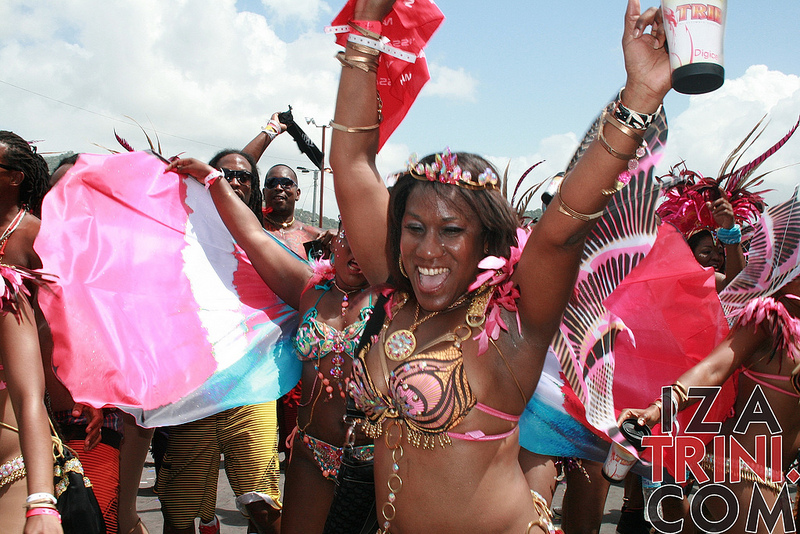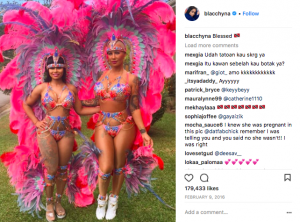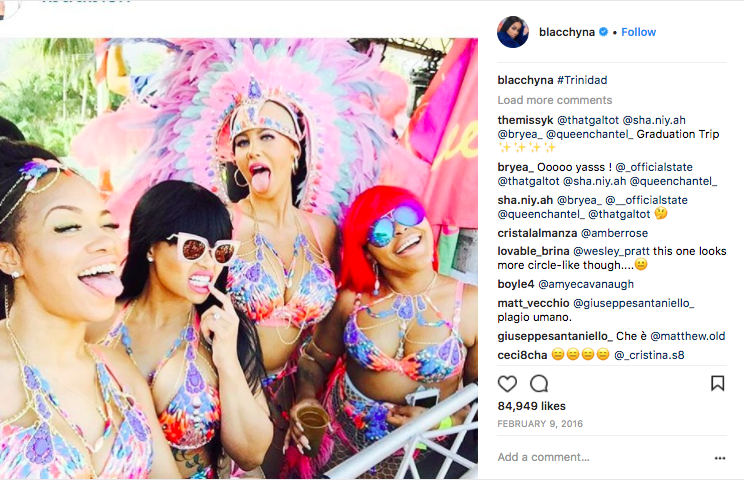Nicki Minaj, Blac Chyna, and Amber Rose celebrate Carnival in Trinidad and Tobago. What does Carnival look like today? Are these stars embracing or appropriating the rich culture of Carnival?
Before Global Theater, I confess that I knew very little about Carnival. My knowledge was confined to depictions of the celebration on social media platforms, particularly to posts by celebrities. Nicki Minaj, Blac Chyna, and Amber Rose have shared their Carnival experience in Trinidad and Tobago with over 100 million Instagram followers. As these global stars highlight an important event in their Trinidad culture, many of their followers lack an understanding of the cultural celebration. My goal is to educate people about the history of Carnival and encourage people to analyze how the celebration is promoted by global stars.
History
Carnival is an annual celebration that began Trinidad and Tobago in 1783. Masquerade dress—playing mas—is a fundamental aspect of Carnival that is rooted in Trinidad and Tobago’s history of oppression and rebellion (Copeland and Hodges 186). For instance, slave owners and plantation owners celebrated the Catholic pre-Lenten “carne-vale” with a masquerade ball in the days leading up to Ash Wednesday (Copeland and Hodges 187). The festivities honored the community’s impending exclusion of meat from their diets for the 40-days of Lent (Copeland and Hodges 187).

As slaveholders and plantation owners attended their masquerade ball, slaves engaged in a separate Carnival celebration (Copeland and Hodges 187). Carnival enabled slaves to express themselves freely. Slaves saw Carnival as an opportunity for united rebellion, because playing mas encouraged role reversal and mockery (Copeland and Hodges 187). For instance, sometimes slaves imitated their master’s behavior to express their hope that they would be emancipated one day (Copeland and Hodges 187). After the emancipation of slavery in 1838, the separate Carnival celebrations in Trinidad and Tobago integrated.
Carnival continued to evolve in the late 1800s, but it remained an opportunity for people from different classes to imitate or embody people from other classes (Copeland and Hodges 187). Carnival revelers used costumes, makeup, and accessories to break free from societal oppression and the confines of everyday life (Copeland and Hodges 187).
Carnival further evolved in the 1940s when women were finally allowed to participate in the festivities. Women seized their opportunity women to partake in the celebrations, and female masqueraders quickly outnumbered male masqueraders (Copeland and Hodges 188). Moreover, the influx of female participants caused the theme of the celebration to shift from rebellion to an occasion for a vivacious social party (Copeland and Hodges 188).

Carnival Today
While traditional masquerade dress at Carnival reflected historical events and folklore, women soon redefined modern Carnival celebrations with their extravagant outfits and their exhibition of pretty mas (Copeland and Hodges 187). Many masqueraders believe that pretty mas is about showcasing the female body and beauty. Female masqueraders often wear swimsuits with elaborate accessories (Copeland and Hodges 187). Also, female masqueraders often wear a headpiece covered in beads and feathers (Copeland and Hodges 187).
Pretty mas is prominent in Carnival attire today, and outfits are becoming increasingly skimpy (Copeland and Hodges 187, 194). For instance, modern day female masqueraders wear microscopic bikinis or lingerie with beads, sequins, and feathers (Copeland and Hodges 192). Women carefully plan their makeup, jewelry and accessories leading up to the event to further enhance the spectacle of their appearance (Copeland and Hodges 194).
Masqueraders love to showcase their bodies and party with their communities, but many participants experience significant backlash for their suggestive attire. Some people argue that younger generations lack respect for the traditions of Carnival and the celebration is losing its authenticity as a result (Copeland and Hodges 188, 196). On the other hand, others believe that modern and traditional Carnival styles can coexist (Copeland and Hodges 196).
Modern technology and social media have publicized Carnival celebrations across the globe. Celebrities often capitalize on the extravagant spectacle of Carnival celebrations to enhance their social media profiles. As Robert Lanham explains in “Economics of Attention,” attention is profitable, and the more attention someone or something attracts, the more attention it will continue to attract.
Many celebrities, like Nicki Minaj, Blac Chyna, and Amber Rose, broadcast their time at Carnival in Trinidad and Tobago to over 100 million followers on Instagram. As Nicki Minaj, Blac Chyna, and Amber Rose publicize their experiences, their representations influence millions of people’s perspectives about the cultural celebration, so it is essential to analyze their content with a critical eye.
Nicki Minaj
Nicki Minaj was born in Trinidad and Tobago, and she features Trinidad Carnival in her “Pound the Alarm” music video. In the video, Minaj parades through the streets of Trinidad and Tobago in Carnival attire. Minaj and her dancers wear elaborate outfits with colorful feathers, sequins, and skimpy bikinis, which is common attire for modern female masqueraders (Copeland and Hodges). When Minaj finished filming her music video, she was proud to show off Carnival celebrations to her fans around the world. Minaj wrote of her video, “Just wrapped an amazing video on an amazing island. #Trinidad #poundthealarm” (Anisobi). Minaj also wrote, “The heat in Trinidad is on another level…The girls in the vid are drop dead gorgeous & I’m not just saying it cuz I’m from here!” (Anisobi).
Nicki Minaj’s “Pound the Alarm” Music Video
Minaj filmed her video at the Trinidad and Tobago Carnival in 2012
While Minaj was clearly delighted with her “Pound the Alarm” music video, many people did not appreciate her tribute to her culture. For instance, one Trinidadian critic noted, “[Minaj] never speaks about our food, fashion or music, our artists, or the most common identifier of Trinidad, our carnival” (Crichlow). Although Minaj highlights Trinidad Carnival in her music video, she is overall inconsistent in her representation of her Trinidadian culture. In fact, the critic stated that Minaj’s dance style and accent reflect Jamaican culture more than her Trinidadian culture (Crichlow). The critic’s comments prompt fans to wonder if Minaj capitalized on the spectacle of Carnival celebration as an opportunity to promote her music rather than honor her culture. Furthermore, the lyrics of Minaj’s “Pound the Alarm” do not mention Trinidad and Tobago or Carnival celebrations at all. In fact, at one point in the song Minaj even says, “I’m in Ibiza.” Although the celebratory theme of “Pound the Alarm” embodies the spirited atmosphere of Carnival, her song is not about the cultural celebration. Perhaps Minaj should have filmed “Pound the Alarm” in Ibiza—like the song states. Minaj then should have created different song about Trinidad Carnival and filmed the music video at the celebration.

Minaj does not have a song that is about Trinidad Carnival directly, but she celebrates her Trinidadian culture in her song “Trini Dem Girls.” Minaj honors her culture in the title and in several lines of her song, but the crude sexual innuendos throughout the song tarnish her attempted cultural tribute. For instance, a Trinidadian critic slammed Minaj for her sexual performance of “Trini Dem Girls” at the 2015 Video Music Awards. The critic explained that Minaj’s explicit dance moves did not reflect Trinidadian dance styles and instead dishonored their culture (Crichlow). The critic continued to state that Minaj’s performance is just another example of Minaj’s “irresponsible” and “dishonest” representation of Trinidad and Tobago to her fans around the world (Crichlow).
Blac Chyna and Amber Rose
While Nicki Minaj is arguably one of the most famous stars from Trinidad and Tobago, Blac Chyna and Amber Rose, along with many others, also celebrate Carnival in Trinidad and Tobago. Blac Chyna is a model and entrepreneur, and she is known for her scandalous relationship with Rob Kardashian following her relationship with Tyga. Amber Rose is a model, dancer, and actress who has collaborated with Kanye West and competed on Dancing With the Stars. Like Nicki Minaj, Blac Chyna and Amber Rose publicized their experiences at Carnival in Trinidad and Tobago to millions of fans.


In their posts, Chyna and Rose wear bedazzled bikinis and extravagant pink-feathered headpieces. Similar to Minaj’s outfit in her “Pound the Alarm” music video, Chyna and Rose exhibit pretty mas as they don typical attire for modern female masqueraders in Trinidad and Tobago. However, both Chyna and Rose are considered notorious attention-seekers in Hollywood, so fans must question whether their representation of Carnival is genuine or just another attempt to use the spectacle of the event to attract attention.
So What?
Whether it is a professional athlete, musician, actor, model, entrepreneur, designer, or political activist, many people have at least one icon they admire. People show their unwavering support for their favorite stars by attending their concerts, autograph signings, meet and greets, sports events, and movie premieres. Today, modern social media has cultivated an unprecedented sense of intimacy between celebrities and fans. Social media gives celebrities the immense power to communicate with millions of people with a tap of a button. When celebrities post content on Twitter, Instagram, and Snapchat, their fans follow their day-to-day activities.
As people encounter unfamiliar cultural events both online and offline going forward, I hope they will be inspired to ask questions about, research, analyze, and appreciate the rich history and cultural meanings behind the events and celebrations. In this case, Nicki Minaj, Amber Rose, and Blac Chyna’s representations of Carnival barely scratch the surface of Trinidad and Tobago’s rich culture and the diversity of Carnival celebrations around the world.
While certain stars will fade in and out of the spotlight over time, stars will continue to emphasize aspects of their lives to fans around the world. As celebrities share aspects of their lives and their cultures, people must respond in a critical and thoughtful manner. People must analyze the intention and execution of the content and question whether or not the content is a genuine tribute to their culture or simply an opportunity for publicity.
Sources
Anisiobi, J J. “Homecoming Parade: Nicki Minaj Returns to Her Native Trinidad to Shoot Colourful Carnival Style Music Video Pound The Alarm.” DailyMail, DailyMail UK, 5 July 2012, www.dailymail.co.uk/tvshowbiz/article-2169325/Nicki-Minaj-returns-native-Trinidad-shoot-colourful-carnival-style-music-video-Pound-The-Alarm.html.
Copeland, Raedene and Hodges, Nancy. “Exploring Masquerade Dress at Trinidad Carnival: Bikinis, Beads, and Feathers and the Emergence of the Popular Pretty Mas.” Clothing and Textiles Research Journal, vol. 32, no. 2, 2014, pp. 186–201. Sage, doi:10.1177/0887302X14531452.
Crichlow, Ayana Malaika. “Nicki Minaj Doesn’t Represent My Trinidad.” Huffington Post, Oath Inc., 24 Sept. 2015, www.huffingtonpost.com/ayana-malaika-crichlow/nicki-minaj-the-so-called_b_8191244.html.
Lanham, Richard A. “The Economics of Attention.” University of Chicago Press, University of Chicago Press, 2006, www.press.uchicago.edu/Misc/Chicago/468828.html.
“Nicki Minaj – Pound the Alarm (Explicit).” Performance by Nicki Minaj, YouTube, Cash Money Records, 31 July 2012, www.youtube.com/watch?v=vdrqA93sW-8.
“Nicki Minaj “Trini Dem Girls” & ‘Bad Blood.” Performance With Taylor Swift 2015 MTV VMA’s.” Performance by Nicki Minaj and Taylor Swift, YouTube, Clevver Music, 30 Aug. 2015, https://www.youtube.com/watch?v=RVx3kUBcmmM
“VMA 2015 | Trini Dem Girls/The Night is Still Young.” Performance with Nicki Minaj, MTVLA, MTV, 30 Aug. 2015, http://www.mtvla.com/mx/vma/videos/vma-2015-trini-dem-girlsthe-night-is-still-young-en-vivo
Images
Blacchyna, “Blessed.” Instagram, 9 Feb. 2016, https://www.instagram.com/blacchyna/
Blacchyna, “#Trinidad.” Instagram, 9 Feb. 2016, https://www.instagram.com/blacchyna/
Falke, Stefan. Moko Jumbies: The Dancing Spirits of Trinidad. Digital image. Stefan Falke. Stefan Falke, n.d. Web. 20. Apr. 2018
IZATRINI.com, IMG_8061.jpg, Digital image, 11 February 2013, Flickr, Accessed 19 April 2018. Licensed under https://creativecommons.org/licenses/by-sa/2.0/legalcode